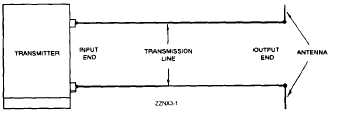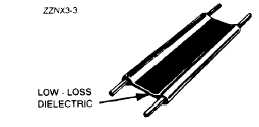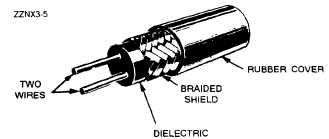Figure 3-9.—Two-wire open
of line is its simple construction.
line.
The principal
disadvantages of this type of line are the high radiation
losses and electrical noise pickup because of the lack
of shielding. Radiation losses are produced by the
changing fields created by the changing current in each
conductor.
Another type of parallel line is the TWO-WIRE
RIBBON (TWIN LEAD) LINE, illustrated in figure
3-10. This type of transmission line is commonly used
to connect a television receiving antenna to a home
television set. This line is essentially the same as the
two-wire open line except that uniform spacing is
assured by embedding the two wires in a low-loss
dielectric, usually polyethylene. Since the wires are
embedded in the thin ribbon of polyethylene, the
dielectric space is partly air and partly polyethylene.
Twisted Pair
The TWISTED PAIR transmission line is illustrated
in figure 3-11. As the name implies, the line consists
of two insulated wires twisted together to form a
flexible line without the use of spacers. It is not used
for transmitting high frequency because of the high
dielectric losses that occur in the rubber insulation.
When the line is wet, the losses increase greatly.
Figure 3-10.—Two-wire ribbon line.
Figure 3-11.—Twisted pair.
Shielded Pair
The SHIELDED PAIR, shown in figure 3-12,
consists of parallel conductors separated from each
other and surrounded by a solid dielectric.
The
conductors are contained within a braided copper
tubing that acts as an electrical shield. The assembly
is covered with a rubber or flexible composition
coating that protects the line from moisture and
mechanical damage. Outwardly, it looks much like
the power cord of a washing machine or refrigerator.
Figure 3-12.—Shielded pair.
The principal advantage of the shielded pair is that
the conductors are balanced to ground; that is, the
capacitance between the wires is uniform throughout
the length of the line.
This balance is due to the
uniform spacing of the grounded shield that surrounds
the wires along their entire length. The braided copper
shield isolates the conductors from stray magnetic
fields.
Coaxial Lines
There are two types of COAXIAL LINES, RIGID
(AIR) COAXIAL LINE and FLEXIBLE (SOLID)
COAXIAL LINE. The physical construction of both
types is basically the same; that is, each contains two
concentric conductors.
3-7








